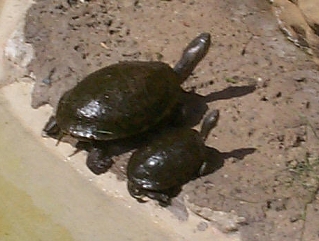Chapter 5. Observing Infrared Radiation
5.1 Introduction

Author: Grace L. Deming, University Of Maryland
Editor: Beth Hufnagel, Anne Arundel Community College

The goals of this module: After completing this exercise, you should be able to:
- Recognize that humans can see only a small range of wavelengths of light, the visible spectrum.
- Describe light as having a range of wavelengths (or frequencies or energies) called a spectrum.
- Compare the information contained in visible and invisible light emitted by objects of differing temperature.
In this module you will explore:
- Wave properties of visible and invisible light.
- How an object's temperature affects emitted light.
Why you are doing it: By understanding that an object's temperature can be revealed by studying the light that it emits, you can learn how astronomers are able to determine the temperature of a distant celestial object. In addition to light that we see using our eyes, there are other forms of light that are invisible.
5.2 Background

Light, also described as electromagnetic radiation, includes invisible as well as visible forms. Study the figure to the right that shows the entire electromagnetic spectrum.
- Gamma rays
- X-rays
- ultraviolet radiation
- infrared radiation
- microwaves
- radio waves
are forms of invisible electromagnetic radiation.
Locate these regions on the figure. Notice that your eyes are sensitive to a very small portion of the electromagnetic spectrum. Electromagnetic radiation can be described by a specific wavelength, frequency, and energy. Wavelengths are shown on the figure. Find the two forms of electromagnetic radiation that are associated with the greatest energy.
Notice that these two forms have the shortest wavelengths. Locate the longest wavelength region shown. How does the energy of this region of the electromagnetic spectrum compare to the shorter wavelength regions?
5.3 Infrared: More Than Your Eyes Can See
The NASA video presentation "Infrared: More Than Your Eyes Can See" features the infrared region of the spectrum. How does the infrared region compare to visible light in terms of wavelength (longer or shorter than visible light) and energy (greater or less than visible light)?
Watch the video presentation.
After viewing, answer the following questions:
Question Sequence
Question 5.1
sV/qr66vTfP/jiM3z+7liL+ucM/wGRhdMQRva6Qk6H8N6Wk6ZRX3hbe0lAMY4ggJbAb8M6ioJB7V3ueCY+9AePK0Jt1oUot/zchv5GhfRAOuYn1HrhnFSIgqpSAtQo6qRa4LMO0GTIBTQWQEUWKnQ6DdmnCvmiISGCG2R1OeWRdX7LQXGHq9zv7JtJc=Question 5.2
x99cBjaU6FicaVuTrNlMPIYsH1wcAYjKgClgvg+jdl5lisj3oWySxGr7nq7vYG5IkzYEZPCb249+DuTBxG94imTshu+kTYwFVGPtAUtakPT9r3Z3lF8kp7cjmtpXMk4rZbBumKFepZhYvhRiA975OcLE1A4X4AYZIb4O0XdkXah9/fSWEbsYB46ap1CRaoim8fJ9Dn1AJu6UwBa2WVC9D1Ytz5Ec5j5Mpm5ZoS4jTxE60+jiHu9DXwH53DHROnvVf/8MeAu60RsQyrpU/zVZScJPa8qVD1wWSGiWLPyhMk74Z6JNhBhMFzGwCI4U40iwrMNR/YLQwBqco9/Z9Ct/UkNaoV8AQKiK/VIvVToUbrTpnwmfMf06cnDebppSBj6C6s6UJ/mzQcFt7mzRX41M7mx9CzVal3GMc72oP9QEBeMZhuqo/+RbtyiTefF0M9nUQBAXgFqMS7lInAZ3GRy+1w==
5.4 Animals' Temperature
The animals that were shown in the video presentation appeared very different. When using an infrared camera, the image is displayed using colors to indicate the corresponding temperature. The colors can be correlated to temperature using a scale, making it very easy to understand which areas are warmer and which are cooler.
Visit this website and compare the images and the temperatures of the Macaw (bird), cat (mammal), and turtles (reptiles). Study the temperature scale given next to each image.
How does the human's temperature compare to the Macaw's temperature? Are they warmer or cooler than their surroundings? Could you see the warm footprints the cat left?


Question 5.3
JTRGGt1zUdtpoklyNTxoaEtO91gKsM0w8sSeiyjJ7Wlsz+DiMeeSrfm+AnQpqaz65d6gq8S5h2CTX1xYFA3tF5hN3qZBKI4KkfjgdF5o+QPo30DlInGeR2bPBfr/cYmDnIIUJ109Smy8FZnt122nBtX2WBll9ChZqk0g4PkoZXigjQAGlIVkkMbH5o3daIOHsvgHPXm6NSP4D+ZnXzxHPh1Uc6rWDHoHnVO5GSPh9dso66p12s7IAqd6BKmVi5eD+4Tfd8UNhD8EBnKf+alyzC3BKjAyWO13kSh64tEOwGCiSN/imUsn5ogKgImy7BK05.5 Celestial Objects Viewed in the Infrared
Astronomers are interested in using infrared cameras to learn more about celestial objects. For these purposes, it is beneficial to divide the infrared region into three sub-regions: the near-infrared, the mid-infrared, and the far-infrared. The prefixes refer to each region's location relative to visible light. For example, the near-infrared is closest in wavelength to red visible light, while the far-infrared has much longer wavelength than visible light.
Visit this website to learn more about what astronomers "see" when they use infrared cameras to study the cosmos.
Consider the Table highlighting which kinds of objects can be studied by collecting infrared data.
Question Sequence
Question 5.4
kr0m765l1UYQguJsci3tp3mMgLwDHwXlHTiR/ASuEpS7fQag7oi98HPkReeHzJwYn3RbIngNAVoHrF51IrdVewg6Xw/ZVkjP0iklA3EtcJdcRr26lC4UkrxjfkGMthv1OD2Ey2OQY/nWr0iKl/WZiBAunVOVk44kZL/oQBAXXF8G5mEpoNq8l/dJuCN/KDWN6Y/n4RTeMzgKg1NqzDsWIfNeW/81S87YC6x97QIYh9WdMEwyLBgUj0J7qAjuhE0Qr+5j6HofXuDXQ5T2/V53lLoVWpwvIXnFp5nOlw==Question 5.5
GfdqCthT4kEXXnc1yS2NpQEc9fb5MAwyyLaIx5uVwMVGAfEELs9WS5gAHXW/ZXLtyMwCQs1W46lYhK6of4YA9Ob+3g/pqv85f+kxBxc8ug3vBqYiWlyKZRi5aCs7RzZVDtv67WHrLDugqykOIGeG5+JUA83jrh/3jI37UvbS4FEYrWY6xJKYUrFtMNRU41M8+4QpWMXho/iI1tP2kVicDbI2Dz5tN1GKr4ajSX1ruMfqqxDWubEsjteXOsSay7wTlz6VibYPoSP2+sHBw4QuzzRzSrcLHHWyyMjqaixHiZeLNvxNR4rYAuas7cnX6nqX7Xtm0jhDIHypqbgWbaahcf4oVPTc205BQ1G4PkSDMbSOINWhL6TilOqD5xYvmG6ET8/UrYzgqa09uKPuwSKkqc9ken504C5gEH64Flhe+RQQE8JrhDdb7PXa8rHGq3+axQXXqOnhKGKBOgY/JJTUMCCLrEj0FVO1RH0olajiGVEop7ulP7uwrhoa0S/11dx5yB68XuU3gSdUnJl6D+moYRPDSNwitECluyMQ9iWyU66RJvTH2ty2TZFrg2IyfZUYr7TERXtKtYQo0BseDreBDJVgZnEFJ0vC7rZQXTItnk08tAwOlUnrI6hRd/YzvLzm2KcGf6NvWHJv3Ft/rFufWhLO+lchhbKoQ0oK0MjD1cGbJ+CXzA5tC0Vwo9T1T9a93m+XTyuqBp6Xi6UartcZWzcQtlUMNRDCS1UqXdRgXVgdjjtfkQamGA1RQNCFFn8HMPJEDelRvUz0gfTCqYKiQfsmblKVeBQjYWjwz3DQhBMh4M10ICpi3w==
5.6 Quick Check Quiz
Indepth Activity: Observing Infrared Radiation
Question 5.6
aHatyVyn2IgEaoXArgy/DdIG6YQhNVHDeSYCzY3J2LvLl+kSpkmPCM8VVKxYJTYvPFD94yeXWLui3m+C46K6wKFXbwFbVRECAexbprQ637j1F0de0XZGk193db8s1UwAQu01yUR5QGv0K4W2+v4YWmjtogI2R0nG9HPJbQ2jt+kQ634r+mqo93KC9fasNOFFxatSn0qd4PFX6WRg/QomEOM921RGukwLpTTf9TJ+0w7vxGt8XLSNc9Gn2ewnN7AsRe9cUxHlTjlRQj6t1oXKHHvc9iSd+a6XPqAQZVNoGNo4p6qY7AqZ+lhDRpF23VgPhQOg63Vu0Io9BFqrGlkZHQWlV1gKsQ0t1mDahqsGxfiv31YsRMDGdv7lE3Ev2JDA4lCUTWXPT/ErZ7ggUylxX4jQiRQqk+TNoUoBtNK3XcX9TCSpYXRV1xftxahuOxq/BlEOAQ==Question 5.7
F4TPYNvne3ZvvpYeypqFstweuu2UpC6BHnIlTgqzmNcWeQO4T25Tjm4LOXfyZGtRVd6gaLs17v86ZgCPqYfHniwXAO79Mho5OIT1LznDN2Ap1JEcXFnjOfq1gAV6xVCvu0akz+SB/XVm3vCFBNLxCUB89/LUsHPrOIZjG+WkxdqazqhIngPcPGGgNGykJVawNjpkVmAiK9MqtTpu47owdYzuQWV+OwMVxPu9RnYAHY12fAnQ8hfUuYiBSFNgn2dLcsJUQVGmjEpJAR5qVW1amzAXckI95MUSTbG+AOKwkuV2x+JdJjYcRjfdsaYf2Onv1oTfdINy+rDuavG6XpepakJYfpwp84lFzEQ9lf66gnGQqZzIBVHZvVIkFcYRO/HsyuPpJFsbmuzuGGCHSQDodA==Question 5.8
EXbSMaDjMjBqJtUYo7YqVIvgu4aGzLOJATYAs2YOFlUrqeXSZIumhQBzi+nwPqvMdK0DSArsIz4oS7cjN1SwC5ekazB2OTA+TwzwuCt114S1vbWhhl9IaKYqRgsLJWa91uly/kqLDiOS2uhgwZyJXNNdURD61NR4lMAMVsiTabr/1WP6vBf8dLTyWTZZWRkPnR0Pw+lDA3qQWeFetithkUY6MSa3PNZ1qn4wpMjl9OUmyG15I8Mgvdr4lneAO6YfQuestion 5.9
f5r5D7CyjVoLzIWxaPNk/fsPRhaBWX8YQm7M0URb4fL24h1p68fC5RIL/+f3loEJ4fWMZdjYiJ6o8ggYDDjhpsG/DvHR5RzEwaVIU6LqikAnLBc9wcxaYKcgZS+E1TUb1+C1HiWYvfY1zRUuPdoxxi6Lwlx5o2wzYNP4bT12TCZKnbV56fYfVibkQXmDiYExHTtFmqBphRgodYcB2WCVz64q+gI=Question 5.10
FKMPyspDZq25sWm24v6ujFAucPijNGS9DJ61O6OJyZJceDl6AoGAIYAdB2QfGPmpSy7arBaGC5jS9kHSMVINlObVA8vx+mOuDnnVumuiUeb5zCTIH9Qw85swoGOTaJx7MlI60GqvXBWj5U/xeE1O6VQmy8/oqHLeO+/9J3BtVTEJzCBQI+GgbpkKYF+RM9tT8oNd6PqiVozawJmR1ouRFw==Question 5.11
BTWXbjCafhJ/2hvVqzahmEaHu4/5JkC3WW6pdsacwMfdcES7rlDe8J1k8XZI7CAWxFtcMDMV1YGOY+shJK50/NS7EKd5Rn1lGNJOmIqnPnn5SMhJr0JiVxUlQtHRb9dmLWrIKUQ3nU/FPIhQ/fA+i9wdbxa/QXRYRMyHNSrAy+rg9F/s/jgFWfq+tPd67+crcagj1Zp8Dc423804hBiZgVM96NJpMh0o1GZVJeb9Lf7asZgYQuestion 5.12
8Mpjaj1sT7m/H0li+UnH+K21ugBjaRfcrH7l4SVdTvcX59nFXfUBokPKDwVXfAu/Otka+mbRr9c/bl+OV2uY/S6Dwa7BTOjT8ZsCZVq9wQLqk8Ls2Vo0uRrhkDBK7x/fKyyGs0S0elX7SfY4IzsbdHNgw5K7gpon70Lt1Zo8XuWgP99DtgvrPf5PO4EKbF0eBCGTHSLtAoUp7RCuK42frw9+Z8HhdsNh8w//CsRcr4YWrVL2WLZ4sQlZ34zdfWgWnvlm6/SxeRMK8ANhEo3getbj+tbumGU0ws17YzAJi07qIj1IKuegFxcgwBl/MMwiJuMIntbrtYkeI3jf2+EiNfUWgaN5ogNEkXhAdg/7puU9Av4p0sDnXPOGmgaKajn69IIHU46OT2FKuuLU9MUWTlSs9qZgnhVs+fimOMF7ihQBJv9eowE64++5uayAAnDPCZZItw==Question 5.13
jSVOR/zR8+D1URD+YUO2C8o/GJCyjvqyhtNoUYB95t93IY7uPYk8lbKjw0kHmF+AnSH0Ell7T75iw42urYT2mKr9025SOW+Zd70oH5APkVDVkCIp7JeI32E6X1nHKS6Sp7lYM9HzY0sJhTDjUQYDhqVL0ostnGniwmTfQDRCmoRYLIRV82qnXa6ctvh8lbfrdKBJyqU51dsXqjw7hWfFZ8yMputsKn0rnq1hflPl5O1myd+aE6wlP6AbrwIuy0pKWEYIKEw5zhFeSTERzFQbXy73mOeM4Qf1iT2PG9papfU61Oy5Sb0Jv3tRtm6Ks8bfPhpCp6NQxIujv6trF0OrEQWq44OWM7KDtSHGGsWbcIhFHH0DLP2PjTboTGHLfv26qqmXlGWRXJ9QjRaOkkbns7sNsCmzoWLxwO6oiKiZ0zkPdpZOQuestion 5.14
AiMFUzQvhnkxJaoP/FxgtPwv0Cnn3g437ocs7HXvtt7fcaLAjQAmcnCHWBbAQaYALjo0D2AWqJTMKK/mxTk9J+XYwNT0N64OBFXuA0aoZkcMwY1ly4j0JVUZEyx5/ZP/X/QJJ0uezmoXiwbCQuestion 5.15
MWJbIBrG1OYVXd5fsvZZnUtywctVFVRDnZIxDx/YilKbmlnEIbBivRrcvn1eRIKvYVDo0mjKDC0N5VfOGW0MKfVJIC/mzHGNwkU+n2g57iRGzOTBTk4kdG+RAoOyYvBAdAwZ9SXL4Phr44qsCtUV//z0S8blQDaMHlOlDpM5y5P/p5Es+rNiyUD1TIuGu2vym5Je08WW7cVcynm+sUObRiNVRo1SLtbMz4UklZJ73mBcW47uQuEkx1qvdEhtOWcgGLC2Syy5kOQQzcuBR9SGTuw2xxijvwSE1ZGMTQ==